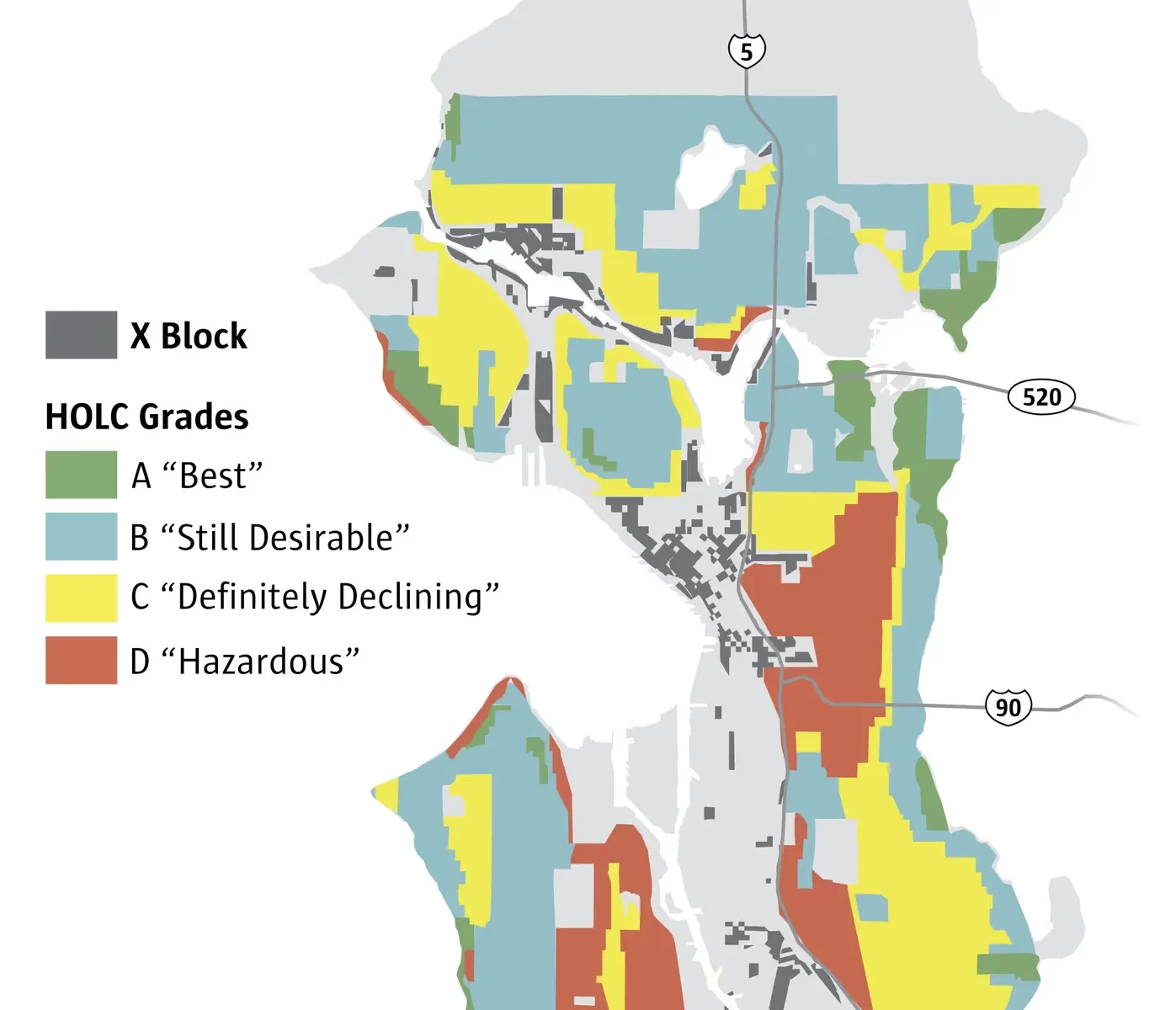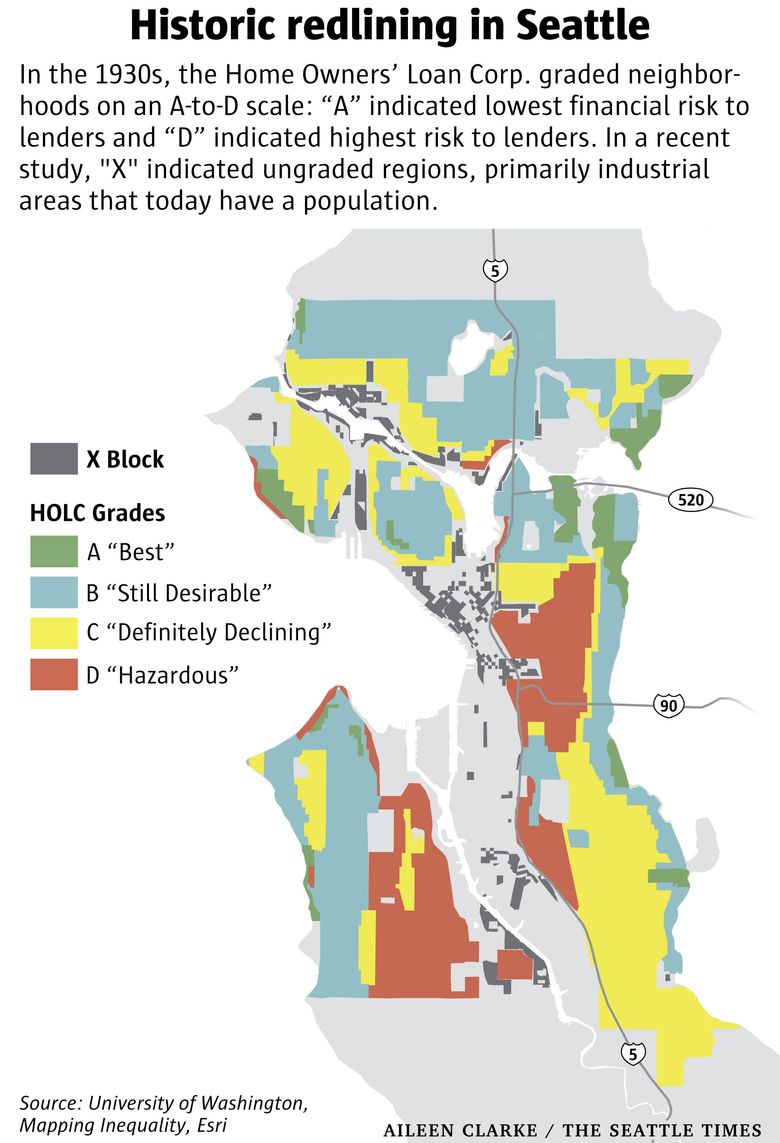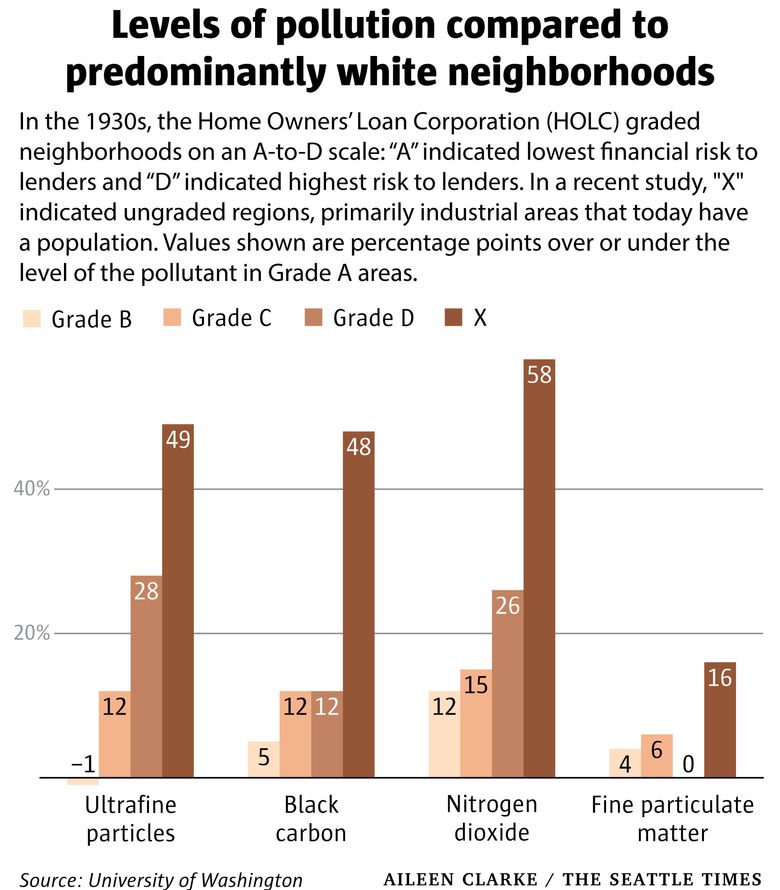As Seattleites awoke to a hazy concoction of wildfire and Fourth of July firework smoke Wednesday morning, a new study dropped, revealing that some neighborhoods in the city are regularly subject to worse air pollution, reflective of historic racist policies.
Those neighborhoods, according to research published Wednesday from the University of Washington, are today living with the impacts of redlining. The racist practice denied people of color and low-income residents access to homeownership, loans and other opportunities to live and build wealth in more “desirable” areas.
Researchers looked at long-term average levels of soot, fine particles, nitrogen dioxide and ultrafine particles. The study, led by an undergraduate student, found that levels of ultrafine particles — a pollutant of emerging interest — reflect the city’s systemic racial and economic inequities.
Ultrafine particles are microscopic pollutants about 700 times thinner than the width of a single human hair. They can spread through wildfire smoke, vehicle exhaust, industrial emissions and airplane fumes.
Studies have shown long-term exposure to fine particles might increase the risk of death from heart disease and be associated with increased rates of chronic bronchitis, reduced lung function and lung cancer. More recently, researchers have found that smaller ultrafine particles can bypass some of the body’s built-in defenses, carrying toxins directly to people’s organs or burrowing deep in the lungs. They have been found to cause more pulmonary inflammation and are retained longer in the lungs than fine particles.
“We actually think that they are potentially a lot more toxic than fine particles,” said senior author Lianne Sheppard, a UW professor in the department of environmental and occupational health sciences.
Neighborhoods classified as “hazardous” under historical redlining practices are today exposed to higher concentrations of all types of pollution than those once labeled “desirable,” the study found. Black and lower-income communities were subject to some of the worst pollution.
While the study didn’t investigate a causal link between redlining and air quality, researchers were able to conclude there is an association.
Much of the research validated a truth that South Seattle residents have long experienced first hand, and that community advocacy groups are working to change.
The study
South Seattle has long borne the burden of hosting some of the city’s biggest polluting industries. Much of that was shaped by redlining, racial covenants and other discriminatory mortgage and land-use processes used to restrict where people could buy or rent property based on income, ethnicity and race.
Starting in the 1930s, the Home Owners’ Loan Corp. graded residential areas by “mortgage security” on an A-to-D scale. Several factors, such as proximity to transportation, amenities, or industry presence, contributed to grading. The maps depicted “Grade D” in a red color, in what became known as redlining.
While the grades were delineated under the leadership of the city’s first elected African American council member in the 1960s, they continue to correlate with present-day social and environmental attributes of Seattle’s neighborhoods. Researchers also assigned the blocks that fell within the ungraded regions “X.” These areas that were largely deemed industrial now host populations, one that “notably has the lowest median income among the HOLC grades,” the study said.
The HOLC maps, cataloged and made accessible through a joint effort by four universities, offer a window into a regrettable chapter of America’s history. But in many ways, and for many people, that chapter hasn’t closed.
Last year, a UW study revealed that formerly redlined neighborhoods across the U.S. still have worse air quality. The new UW study published this week took a closer look at the impact in Seattle, specifically how ultrafine particles disproportionately impact the city’s neighborhoods shaped by historical redlining.
Kaya Bramble, the study’s lead author, who graduated from the UW in 2022 with a degree in industrial and systems engineering, received a grant from the National Institute of Environmental Health Sciences to pursue the research. The institute awards funding and mentorship to undergraduates from underrepresented backgrounds to dive into topics like these.
Bramble was interested in how income, race and historical racist policies determine the quality of air people breathe. Bramble, who was raised near Interstate 5 in Tacoma, said the results didn’t surprise her. She’d read studies that drew the link between redlining, socioeconomic factors and things like extreme heat and access to green space.
Researchers gathered race and ethnicity data from the 2010 U.S. census, median household income data from the 2006 to 2010 American Community Survey, and Home Owners’ Loan Corp. redlining data from the University of Richmond’s Mapping Inequality.
They used air quality data collected by a car loaded with air pollution sensors that drove around the city for about a year in 2019 and 2020 to examine long-term average levels of soot, fine particles, nitrogen dioxide and ultrafine particles.
They found the highest concentrations of all four pollutants existed on census blocks with average household incomes under $20,000 and those with proportionately larger Black populations.
Those city blocks had long-term ultrafine particle concentrations 40% higher than the study region average. Meanwhile, blocks where median incomes are over $110,000 saw ultrafine particle concentrations 16% lower than average.
Black residents had the highest exposures to all four pollutants.
In the previously ungraded industrial areas, ultrafine particle concentrations were 49% above average.
“We actually found higher air pollution in those areas,” said Sheppard, the senior author. “That was an interesting and surprising finding to me — I was surprised that it was even worse than those graded hazardous.”
Community, context
The new research builds on a mountain of existing research on the disproportionate affects of pollution and climate change in South Seattle. It validates what many residents have said for decades.
“The folks in the Duwamish Valley,” said Christian Poulsen, Clean Air Program lead for the Duwamish River Community Coalition, “we subsidize economic activity with our health.”
A study funded by the Environment Protection Agency found in 2013 that residents of the Duwamish Valley on average are sicker and die younger than those living in other parts of Seattle.
A 2017 study partially funded by the EPA found that among children, more exposure to higher levels of fine particulate matter is strongly associated with an increased risk of asthma and death. In 2019, UW researchers found emissions from planes are disproportionately polluting communities near Seattle-Tacoma International Airport with these ultrafine particles.
This pollution, according to a lawsuit filed this year, contributes to shorter life expectancy compared with other King County cities; premature births; over 100 excess deaths per year on average; and more deaths caused by cancer, heart disease and chronic lower respiratory disease.
The connection between air pollution and the elevated risk among children of developing asthma is also well documented.
Chronic disinvestment at the local and state level in communities of color and neighborhoods with lower incomes has led community advocacy groups like Duwamish River Community Coalition to fend for themselves and empower the youth to do the same.
Poulsen, a member of the King County International Airport Community Coalition, has been advocating for communities directly impacted by airplane and industry pollution to have a say in policymaking decisions. Poulsen helped shape one bill that was killed in the state Senate last session that looked to speed up the phaseout of the use of leaded airplane fuels.
In 2019 and 2021, the Duwamish Valley Youth Corps collected moss samples from all over the valley and sent them to be tested for metals — moss is known to trap heavy metals from the air. The results revealed higher levels of lead in the valley than other industrialized areas along Puget Sound and higher than the national average.
“I’m raising two kids in South Park right now,” Poulsen said. “And this is something that can’t be addressed over 30, 40 years. This is something that’s impacting the health of our children now.”
The coalition is working with more than two dozen community partners to improve indoor and outdoor air quality for the community.
“It’s not just an episode of fireworks,” said Paulina López, executive director of the coalition. “That might be gone in a couple of days, but this is the air that we breathe every day. So how do we create real change — meaningful change — with the involvement of the community and start to acknowledge these cumulative effects.”
Beyond air pollution, the Duwamish River is a Superfund site, there are major highways that flank the community, and massive truck and bus depots are nearby.
But gaps in air quality monitoring largely remain in South Seattle, said Troy Abel, professor of environmental policy at Western Washington University.
“So studies like this — it’s an illustration that when you do more granular, finer scale air pollution monitoring, you really see the disparities,” Abel said. “Both in location, but more importantly, people of color are going to experience more air pollution disparities than white communities across Seattle.”
This report includes material from The Seattle Times archives.


